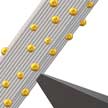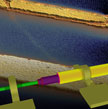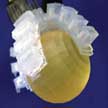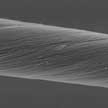Showing Spotlights 9 - 16 of 318 in category All (newest first):
 Individual single-walled carbon nanotubes (SWCNTs) have thermal conductivity that is several times higher than copper. However, once researchers start to assemble SWCNTs into macroscale composites, fibers or films, they notice that thermal conduction drops significantly. Employing in situ transmission electron microscopy, researchers visualized a colossal anisotropy of thermal conductivity of nanoscale materials. The team says that their methodology to visualize nanoscale thermal transport is not limited to carbon nanotubes.
Individual single-walled carbon nanotubes (SWCNTs) have thermal conductivity that is several times higher than copper. However, once researchers start to assemble SWCNTs into macroscale composites, fibers or films, they notice that thermal conduction drops significantly. Employing in situ transmission electron microscopy, researchers visualized a colossal anisotropy of thermal conductivity of nanoscale materials. The team says that their methodology to visualize nanoscale thermal transport is not limited to carbon nanotubes.
Apr 6th, 2021
 The properties ofvan der Waals heterostructures can be precisely controlled by twisting the stacked atomic layers, opening the way for the use of this unique degree of freedom for the nanoscale control of composite materials and nano-devices in future technologies. New work suggests that all 2D materials could also be rolled into their 1D counterparts and a plethora of function-designable 1D heterostructures could be realized. Unlike semiconductor nanowires or mono-elemental nanotubes, which are rolls of one type of material, these novel nanostructures would have very different, and customizable, properties.
The properties ofvan der Waals heterostructures can be precisely controlled by twisting the stacked atomic layers, opening the way for the use of this unique degree of freedom for the nanoscale control of composite materials and nano-devices in future technologies. New work suggests that all 2D materials could also be rolled into their 1D counterparts and a plethora of function-designable 1D heterostructures could be realized. Unlike semiconductor nanowires or mono-elemental nanotubes, which are rolls of one type of material, these novel nanostructures would have very different, and customizable, properties.
Mar 2nd, 2021
 A novel method for fast and accurate local tuning of the optoelectronic properties of single-walled carbon nanotubes makes use of ultrafast-pulsed lasers. The method is based on localized two-photon oxidation of carbon nanotubes when the laser irradiates with energies far below the ablation threshold. At such low energies the nonlinear photochemical interaction of femtosecond laser and carbon atomic lattice prevent thermal effects.
A novel method for fast and accurate local tuning of the optoelectronic properties of single-walled carbon nanotubes makes use of ultrafast-pulsed lasers. The method is based on localized two-photon oxidation of carbon nanotubes when the laser irradiates with energies far below the ablation threshold. At such low energies the nonlinear photochemical interaction of femtosecond laser and carbon atomic lattice prevent thermal effects.
Feb 8th, 2021
 Breath is one of the main sources of human health parameters that can be used for predicting the state of internal organs. Exhaled breath composition is very complex and the existence of disease marker molecules can be as low as one part per million. That means that using breath for health monitoring purposes requires highly sensitive tools with a recognition ability down to single molecules. Researchers developed a method for fast, on-site and still accurate breath analysis that does not need special preparation of breath samples. The method is based on an electronic nose platform that uses a set of single-walled carbon nanotube sensors deposited on flexible substrates and modified by different semiconducting organic molecules.
Breath is one of the main sources of human health parameters that can be used for predicting the state of internal organs. Exhaled breath composition is very complex and the existence of disease marker molecules can be as low as one part per million. That means that using breath for health monitoring purposes requires highly sensitive tools with a recognition ability down to single molecules. Researchers developed a method for fast, on-site and still accurate breath analysis that does not need special preparation of breath samples. The method is based on an electronic nose platform that uses a set of single-walled carbon nanotube sensors deposited on flexible substrates and modified by different semiconducting organic molecules.
May 13th, 2020
 Researchers exploited for the first time cellular self-recognition process for targeting glioblastoma cells with boron nitride nanotubes (BNNTs), a biocompatible, yet inorganic, nanomaterial.
The team loaded the BNNTs with doxorubicin, a powerful chemotherapy drug, and then functionalized them with glioblastoma cell membranes This targeting approach benefits from the ability of cancer cells to recognize each other due to similarities present on their membrane that make them different from healthy cells.
Researchers exploited for the first time cellular self-recognition process for targeting glioblastoma cells with boron nitride nanotubes (BNNTs), a biocompatible, yet inorganic, nanomaterial.
The team loaded the BNNTs with doxorubicin, a powerful chemotherapy drug, and then functionalized them with glioblastoma cell membranes This targeting approach benefits from the ability of cancer cells to recognize each other due to similarities present on their membrane that make them different from healthy cells.
May 11th, 2020
 Electronic skin (e-skin) technology will give prosthetics and soft robotics a finer sense of touch, of what's hard and soft, hot and cold, smooth and rough. Researchers have now demonstrated a soft robotic hand integrated with four tactile force sensors and one temperature sensor to give it similar sensitivity to a human hand. By integrating an e-skin, the tactile pressure to grab an object and the friction movement of an object from the hand can be monitored. Thanks to the arrangement of multiple tactile sensors, e-skin-integrated soft robotic hand also can monitor sliding of an object by detecting the time delay of the tactile force.
Electronic skin (e-skin) technology will give prosthetics and soft robotics a finer sense of touch, of what's hard and soft, hot and cold, smooth and rough. Researchers have now demonstrated a soft robotic hand integrated with four tactile force sensors and one temperature sensor to give it similar sensitivity to a human hand. By integrating an e-skin, the tactile pressure to grab an object and the friction movement of an object from the hand can be monitored. Thanks to the arrangement of multiple tactile sensors, e-skin-integrated soft robotic hand also can monitor sliding of an object by detecting the time delay of the tactile force.
Jun 20th, 2019
 Carbon nanotube (CNT) fiber is an important one-dimensional macroscopic material. The directional assembly of CNTs can help the fiber realize high mechanical, high electrical and high thermal performance. By introducing thermosetting polymer between the carbon nanotube fibers, the cured polymer can overcome the weak van der Waals interaction between the CNTs and further improve the fiber thermal transport. This results in an effective improvement in thermal conductivity and mechanical properties of CNT fibers.
Carbon nanotube (CNT) fiber is an important one-dimensional macroscopic material. The directional assembly of CNTs can help the fiber realize high mechanical, high electrical and high thermal performance. By introducing thermosetting polymer between the carbon nanotube fibers, the cured polymer can overcome the weak van der Waals interaction between the CNTs and further improve the fiber thermal transport. This results in an effective improvement in thermal conductivity and mechanical properties of CNT fibers.
May 21st, 2019
 Despite the rise of graphene and other two-dimensional (2-D) materials, semiconducting single-walled carbon nanotubes are still regarded as strong candidates for the next generation of high-performance, ultra-scaled and thin-film transistors as well as for opto-electronic devices. In new work, a European team of researchers demonstrates simultaneous confinement of electrons and holes between artificial defects separated by less than 10 nm in semiconducting carbon nanotubes.
Despite the rise of graphene and other two-dimensional (2-D) materials, semiconducting single-walled carbon nanotubes are still regarded as strong candidates for the next generation of high-performance, ultra-scaled and thin-film transistors as well as for opto-electronic devices. In new work, a European team of researchers demonstrates simultaneous confinement of electrons and holes between artificial defects separated by less than 10 nm in semiconducting carbon nanotubes.
Mar 16th, 2018
 Individual single-walled carbon nanotubes (SWCNTs) have thermal conductivity that is several times higher than copper. However, once researchers start to assemble SWCNTs into macroscale composites, fibers or films, they notice that thermal conduction drops significantly. Employing in situ transmission electron microscopy, researchers visualized a colossal anisotropy of thermal conductivity of nanoscale materials. The team says that their methodology to visualize nanoscale thermal transport is not limited to carbon nanotubes.
Individual single-walled carbon nanotubes (SWCNTs) have thermal conductivity that is several times higher than copper. However, once researchers start to assemble SWCNTs into macroscale composites, fibers or films, they notice that thermal conduction drops significantly. Employing in situ transmission electron microscopy, researchers visualized a colossal anisotropy of thermal conductivity of nanoscale materials. The team says that their methodology to visualize nanoscale thermal transport is not limited to carbon nanotubes.
 Subscribe to our Nanotechnology Spotlight feed
Subscribe to our Nanotechnology Spotlight feed





